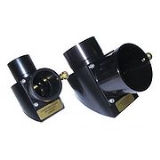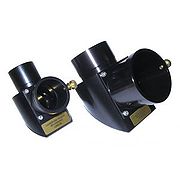
Star diagonal
Encyclopedia
A star diagonal is an angled mirror or prism used in telescope
s that allows viewing from a direction that is perpendicular to the usual eyepiece axis. It allows more convenient and comfortable viewing when the telescope is pointed at, or near the zenith
(i.e. directly overhead). Also, the resulting image is right side up, but is reversed from left to right. Star diagonals are available in 1.25" and 2" diameters. The 2" diagonals allow larger longer focal length low power 2 inch barrel eyepieces for a greater field of view. Star diagonals come in all price ranges, from as low as thirty dollars up to hundreds of dollars. However , even an expensive star diagonal will deliver poor performance if it is not in alignment with the optical axis of the telescope. A telescope in perfect collimation will be thrown out of collimation by a misaligned star diagonal and often this misalignment will determine the image quality of the telescope to a larger extent than the surface accuracy of the prism or mirror. Since the mirror or prism of the star diagonal is located nearly at the focal plane of the instrument, surface accuracy of greater that 1/4 wave is more in the line of advertising than any increase in optical performance. A 1/10 wave mirror or prism star diagonal that throws off the collimation of the telescope will perform worse than a 1/2 wave star diagonal that is in proper alignment.

These diagonals (often called Star diagonals) use a mirror
set at a 45° angle inside the diagonal to turn the telescope’s image at a 90° angle to the rear cell. Mirror diagonals produce an image in the eyepiece
that is correctly oriented vertically, but is reversed left-to-right horizontally. This causes image reversal, the view in the eyepiece is flipped left-right. The major advantage to mirror diagonals is that they cost less to produce to a high degree of optical accuracy compared to a prism and that they do not introduce any color errors to the image. The major disadvantage of mirror diagonals is that unless the reflective coating is properly applied they can scatter light rendering lower image contrast compared to a 90-degree prism. Also they deteriorate with age as the reflective surface oxidizes. The newer Dielectric mirrors have largely solved the deterioration problem, and if properly made the Dielectric mirrors scatter less light compared to conventional mirrors. With short focal length instruments a mirror diagonal is preferred over a prism.
Prism diagonals:
A prism diagonal uses either a simple 90-degree angle prism or an Amici roof prism rather than a mirror to bend the light path. A simple 90-degree angle prism provides the same "flipped" or mirror reversed image as a mirror diagonal. An amici roof prism on the other hand provides a correct non-reversed view. This means that what is seen in the eyepiece is the same as what is seen when looking at the sky, or a star chart or lunar map. The disadvantage of typical "correct image" Amici roof prism diagonals is that because the light path bounces around through a piece of glass, the total amount of light transmitted is less and the multiple reflections required can introduce optical aberrations. Therefore most Amici roof prisms are more appropriate for low power viewing or for use in spotting scopes for terrestrial rather than astronomical use. On the other hand, a well-made conventional 90-degree prism star diagonal can transmit as much or more light as a mirror, and do so with higher image contrast since there is no possibility of light scattering from a reflective metallic surface as in a mirror diagonal. Also a prism will never degrade over time as a mirror will since there is no reflective metal coating to degrade from oxidation. However prism diagonals may introduce chromatic aberration
when used with short focal-length scopes although this isn’t a problem with the popular Schmidt-Cassegrain and Maksutov Cassegrain telescope
s, which have long focal length
s. On longer focal ratio telescopes a well-made 90-degree prism diagonal is the optimum choice to deliver the highest image contrast short of using the telescope without a diagonal entirely. However prisms seem to be falling out of favor probably due to marketing forces which have been favoring short focal length instruments which tend to function better with a mirror diagonal. In some special cases however, the color dispersion effects of a prism diagonal can be used to advantage to improve the performance of undercorrected refractor objectives (regardless of focal length) by shifting the spherical and color correction of the objective closer to the design optimum. The natural color dispersion properties (overcorrection) of the prism works to lessen or nullify the undercorrection of the objective lens.
Telescope
A telescope is an instrument that aids in the observation of remote objects by collecting electromagnetic radiation . The first known practical telescopes were invented in the Netherlands at the beginning of the 1600s , using glass lenses...
s that allows viewing from a direction that is perpendicular to the usual eyepiece axis. It allows more convenient and comfortable viewing when the telescope is pointed at, or near the zenith
Zenith
The zenith is an imaginary point directly "above" a particular location, on the imaginary celestial sphere. "Above" means in the vertical direction opposite to the apparent gravitational force at that location. The opposite direction, i.e...
(i.e. directly overhead). Also, the resulting image is right side up, but is reversed from left to right. Star diagonals are available in 1.25" and 2" diameters. The 2" diagonals allow larger longer focal length low power 2 inch barrel eyepieces for a greater field of view. Star diagonals come in all price ranges, from as low as thirty dollars up to hundreds of dollars. However , even an expensive star diagonal will deliver poor performance if it is not in alignment with the optical axis of the telescope. A telescope in perfect collimation will be thrown out of collimation by a misaligned star diagonal and often this misalignment will determine the image quality of the telescope to a larger extent than the surface accuracy of the prism or mirror. Since the mirror or prism of the star diagonal is located nearly at the focal plane of the instrument, surface accuracy of greater that 1/4 wave is more in the line of advertising than any increase in optical performance. A 1/10 wave mirror or prism star diagonal that throws off the collimation of the telescope will perform worse than a 1/2 wave star diagonal that is in proper alignment.

Types of diagonals
Mirror (reflective) diagonals:These diagonals (often called Star diagonals) use a mirror
Mirror
A mirror is an object that reflects light or sound in a way that preserves much of its original quality prior to its contact with the mirror. Some mirrors also filter out some wavelengths, while preserving other wavelengths in the reflection...
set at a 45° angle inside the diagonal to turn the telescope’s image at a 90° angle to the rear cell. Mirror diagonals produce an image in the eyepiece
Eyepiece
An eyepiece, or ocular lens, is a type of lens that is attached to a variety of optical devices such as telescopes and microscopes. It is so named because it is usually the lens that is closest to the eye when someone looks through the device. The objective lens or mirror collects light and brings...
that is correctly oriented vertically, but is reversed left-to-right horizontally. This causes image reversal, the view in the eyepiece is flipped left-right. The major advantage to mirror diagonals is that they cost less to produce to a high degree of optical accuracy compared to a prism and that they do not introduce any color errors to the image. The major disadvantage of mirror diagonals is that unless the reflective coating is properly applied they can scatter light rendering lower image contrast compared to a 90-degree prism. Also they deteriorate with age as the reflective surface oxidizes. The newer Dielectric mirrors have largely solved the deterioration problem, and if properly made the Dielectric mirrors scatter less light compared to conventional mirrors. With short focal length instruments a mirror diagonal is preferred over a prism.
Prism diagonals:
A prism diagonal uses either a simple 90-degree angle prism or an Amici roof prism rather than a mirror to bend the light path. A simple 90-degree angle prism provides the same "flipped" or mirror reversed image as a mirror diagonal. An amici roof prism on the other hand provides a correct non-reversed view. This means that what is seen in the eyepiece is the same as what is seen when looking at the sky, or a star chart or lunar map. The disadvantage of typical "correct image" Amici roof prism diagonals is that because the light path bounces around through a piece of glass, the total amount of light transmitted is less and the multiple reflections required can introduce optical aberrations. Therefore most Amici roof prisms are more appropriate for low power viewing or for use in spotting scopes for terrestrial rather than astronomical use. On the other hand, a well-made conventional 90-degree prism star diagonal can transmit as much or more light as a mirror, and do so with higher image contrast since there is no possibility of light scattering from a reflective metallic surface as in a mirror diagonal. Also a prism will never degrade over time as a mirror will since there is no reflective metal coating to degrade from oxidation. However prism diagonals may introduce chromatic aberration
Chromatic aberration
In optics, chromatic aberration is a type of distortion in which there is a failure of a lens to focus all colors to the same convergence point. It occurs because lenses have a different refractive index for different wavelengths of light...
when used with short focal-length scopes although this isn’t a problem with the popular Schmidt-Cassegrain and Maksutov Cassegrain telescope
Maksutov telescope
The Maksutov is a catadioptric telescope design that combines a spherical mirror with a weakly negative meniscus lens in a design that takes advantage of all the surfaces being nearly "spherically symmetrical". The negative lens is usually full diameter and placed at the entrance pupil of the...
s, which have long focal length
Focal length
The focal length of an optical system is a measure of how strongly the system converges or diverges light. For an optical system in air, it is the distance over which initially collimated rays are brought to a focus...
s. On longer focal ratio telescopes a well-made 90-degree prism diagonal is the optimum choice to deliver the highest image contrast short of using the telescope without a diagonal entirely. However prisms seem to be falling out of favor probably due to marketing forces which have been favoring short focal length instruments which tend to function better with a mirror diagonal. In some special cases however, the color dispersion effects of a prism diagonal can be used to advantage to improve the performance of undercorrected refractor objectives (regardless of focal length) by shifting the spherical and color correction of the objective closer to the design optimum. The natural color dispersion properties (overcorrection) of the prism works to lessen or nullify the undercorrection of the objective lens.

